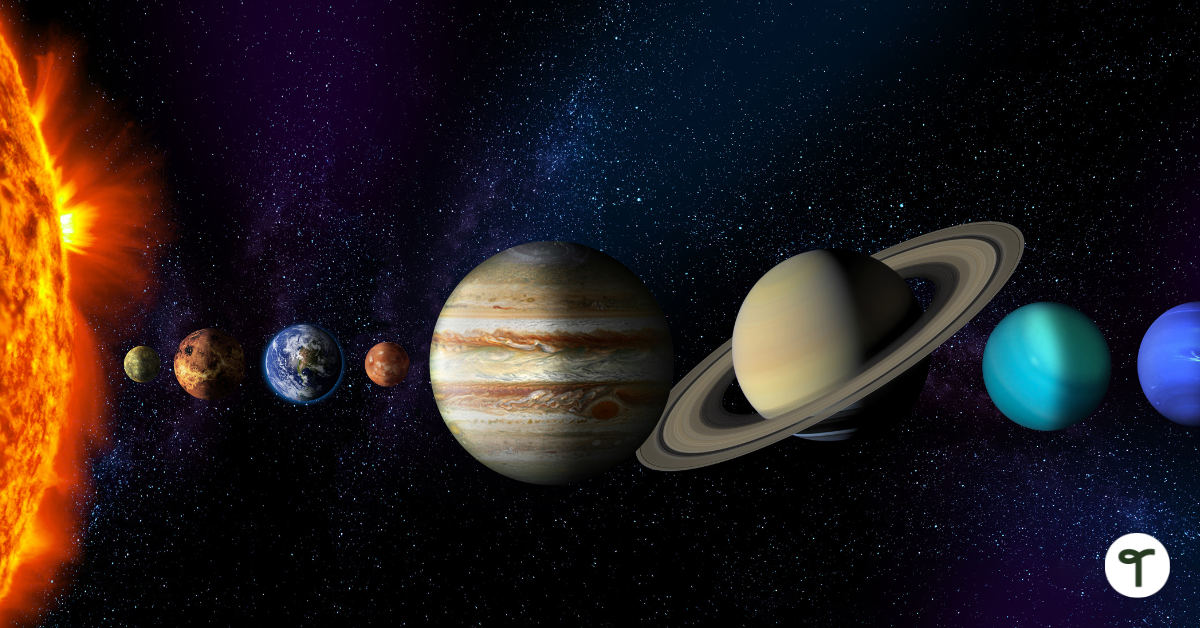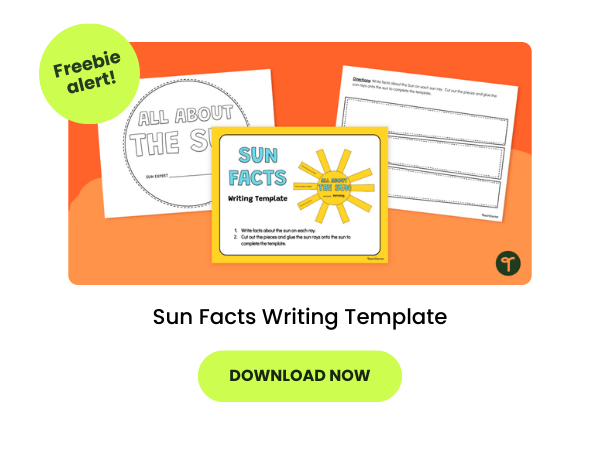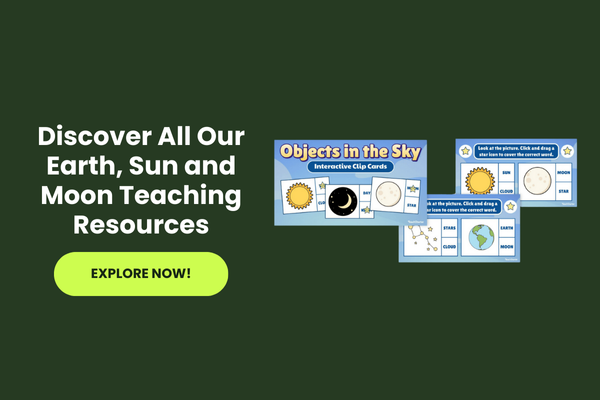Brighten your lessons about the solar system with some fun facts about the sun! We can thank the sun for many wonderful things — toasty days, blooming flowers, our weather patterns, the water cycle and so much more, and we’re adding these interesting tidbits to the list.
With so many science lessons springing from the sun, the Teach Starter teacher team has created a list of fun facts about the sun to spark curiosity in the classroom about the world around us. You’ll find answers to your students’ burning (literally!) questions from “how hot is the sun” to “how big is the sun,” plus some solid science comparing the sun to the earth.
Use these facts for a game of trivia, to kickstart a research project or even to guide science experiments. We’ve also included a few teacher-approved ways to pop these facts into your lesson planning, so let’s dive in!
Fun Facts About The Sun for Kids
1. Ever wondered, “How big is the sun?” Well, that warm, bright beam of light in the sky is a whopping 865,370 miles in diameter.
2. The sun is so big that more than a million Earths could fit inside it. Woah!
3. The sun’s surface, the photosphere, is blistering at 9,932 degrees Fahrenheit. That makes a hot summer sound not so bad!
4. Did you know that the sun is not a planet? It is actually a star and the only one in our solar system.
5. Without the heat and light from the sun, humans would not be able to live on Earth.
6. Although the sun looks like a giant orb from Earth, it is still around 94.5 million miles away! That is 400 times farther than the distance between the moon and the Earth.
7. The sun is around 4.5 billion years old. It was made when a spinning nebula of gas and dust collapsed, forming a disk shape.
8. Even though the sun is very old, it is roughly only halfway through its life cycle! The sun is currently in a phase called “yellow dwarf,” meaning it is a medium-sized star. It will take another 5 billion years for the sun to become a big, cool star called a “red giant.” Then, at the end of its lifestyle (another few billion years!), it will shrink to become a small “white dwarf” star.

9. The sun is mainly made up of hydrogen and helium, making it a steamy ball of plasma instead of a solid mass.
10. We know that it helps warm our day, but just how hot is the sun? The sun’s core is around 27 million degrees Fahrenheit, meaning no life force could ever survive on the sun. Yikes!
11. The sun’s gravity is so fierce that it holds the entire solar system together, and everything revolves around it — the planets, comets, asteroids and pieces of space debris.
12. The sun emits a constant stream of particles called the solar wind. When the solar wind collides with atoms of oxygen and nitrogen from the Earth’s atmosphere, it can cause beautiful flashes of colorful light in the night sky, known as auroras.
13. The sun is made up of outer and inner layers that spin at varying rates, but on average, it rotates on its axis every 27 days.
14. The sun is so far from Earth that sunlight takes about 8 minutes to reach us! This is known as the speed of light.
15. “Sunspots” are cooler regions on the sun’s surface that look darker than the surrounding areas. These sunspots can be larger than Earth!
16. Your students may already know that a solar eclipse occurs when the moon passes between the sun and Earth, blocking the sun’s light, but did you know there are four types of solar eclipses? When a “total” solar eclipse occurs, you can see the outer atmosphere of the sun, whereas “partial” and “annular” solar eclipses happen when the sun, moon and Earth don’t line up, causing only a part of the sun to be in shadow. On rare occasions, a “hybrid” solar eclipse can occur. That means the eclipse can look like an annular or total eclipse depending on where you live on Earth’s curvature.
17. The sun has an outer atmosphere or “chromosphere” with a strong magnetic force. In this area, large explosions of energy and particles create solar flares and coronal mass ejections that can be seen from Earth.
18. Ever noticed grey, reflective rectangles on some roofs? These are called solar panels! Solar panels harness energy from the sun to generate electricity for homes. Almost four percent of U.S. single-family homes generated electricity from solar panels in 2020.
19. The sun’s mass accounts for about 99.86 percent of the solar system’s total mass.
20. Teaching sun safety to kids is incredibly important! Overexposure to the sun can cause severe skin damage.
21. Did you know? The sun’s ultraviolet (UV) rays are a source of Vitamin D, which is crucial for humans. Vitamin D helps keep bones healthy and prevent diseases that make bones weak, such as rickets!
21. As the sun generates more helium, it becomes hotter and brighter. This is a process that has happened over billions of years!
23. The sun has been a symbol in many cultures, religions and mythologies worldwide. For example, the Ancient Egyptians worshipped a sun God, Ra.
24. You should never look directly at the sun! The sun emits ultraviolet (UV) rays that can cause a sunburn on the corneas of your eyes.
25. As Earth orbits the sun, it rotates along an oval-shaped path rather than a perfect circle. That means the distance between the Earth and the sun changes throughout the year.
How to Use These Fun Facts in Your Classroom
- Solar System Model. Create a scaled 2D version of the solar system using craft materials. Students can analyze the physical appearance of key planets individually or in small groups using science reference images to help trace and color them in. Then, take a large piece of black cardboard and place a sun cutout in one corner. Use the scale to map the distance from each planet relative to the sun before gluing them. Students could use the fact above about the distance from the Earth to the sun to get started!
- Solar Eclipse Simulation. Use the facts about a solar eclipse to support your science lessons! To create the simulation, take a flashlight, a globe or ball to represent the moon, and a larger ball to represent the Earth. Shine the flashlight on the “moon” to represent the sun, and move it between the flashlight and the larger ball to create a shadow on the “Earth,” simulating a solar eclipse.
- Sun Fact Trivia. In addition to your core lesson plans, you could turn these fun facts into a game of space-themed trivia. The class can break out into small groups and test their knowledge and decision-making skills and learn interesting new facts about the world around them.











Comments